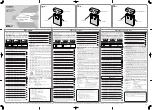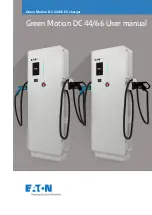
[
8
]
4 – Operation and Charging
4-1 Determine Charging Voltages
To determine the appropriate equalization (freshening) charge voltage and float charge voltage, multiply the number of batteries
connected in series in the battery cabinet by the recommended charging voltage per unit.
For example:
A +/- 240 VDC cabinet containing 40 each of the UPS12-400MR batteries in series would use the following charging voltages:
Freshening/Equalization Charge Voltage = 20 x 14.4 VDC/unit average= +/- 288 VDC
Float Charge Voltage = 20 x (13.5 to 13.8 VDC/unit average) = +/- 270 to 276 VDC
Note: Some battery cabinets may contain more than one series string connected in parallel within the cabinet. The calculation for
properly charging the battery cabinet should follow the procedure above, considering the number of batteries in a single series string.
4-2 Initial Charge
After the correct charging voltages have been calculated, follow these steps:
1.
Adjust the charger/rectifier equalization and float voltage outputs to the appropriate level.
2.
Place the charger/rectifier in equalization mode,
3.
Close the disconnect switch/circuit breaker connection from the charger/rectifier to the battery cabinet(s) and start a 24-hour
freshening charge at the equalization charge.
4.
After a few minutes on charge, monitor the voltage across several of the individual batteries to assure they are charging at the
proper value.
5.
Following completion of the freshening charge, place the charger/rectifier in float charge mode.
6.
After the battery cabinet has been on float for 1 to 24 hours, complete the operational check (
Section 4-3
).
4-3 Operational Check
1.
Measure and record the total system float voltage. Measure at the battery terminals.
2.
Measure and record the system float current using a clamp-on ammeter.
3.
Measure and record the float voltage of individual battery units.
4.
Measure and record the temperature of several of the batteries. (Measure battery temperature with a digital thermometer by
placing the surface thermocouple on the flat surface of the negative terminal—not the “L” connection surface. An infrared
temperature monitor can also be used.)
5.
Optional: Perform impedance and conductance tests on individual battery units. These tests require special equipment, but the
data can be useful in trending the system over time or identifying suspect units during later periodic checks. It may be
necessary to disconnect the battery system from the charger/load during these checks.
6.
If the acceptance test is being performed, proceed to
Section 4-4
. If the acceptance test is not being performed, reinstall the
cabinet’s access panels. The battery cabinet is now in operation.
4-4 Acceptance Test (Optional)
1.
Remove the battery cabinet’s access panels to access internal components. Use a digital voltmeter when voltage
measurements are required.
2.
Determine the discharge rate (e.g. 15 seconds, 5 minutes, 15 minutes) at which the battery is to be tested.
3.
Select a battery from the center of the battery cabinet and measure the temperature at the flat surface of the negative terminal.
If the temperature is below 74° F or above 80° F, the test load should be temperature compensated accordingly.
4.
Review the final check data and assure that all unit float voltages are acceptable.
5.
During the acceptance discharge test, monitor the cabinet system output voltage at the cabinet, the output current and
discharge time as a back-up to monitoring at the critical load.
6.
Run the test in accordance with the IEEE standard.
7.
Reinstall the cabinet’s access panels. The battery cabinet is now in operation.


































